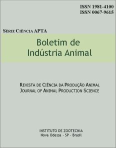Influência das castrações cirúrgica e química na produção e qualidade de carne de bovinos de corte
Resumo
Em delineamento experimental Inteiramente casualizado, 21 bovinos machos da raça santa-gertrúdis, com idade inicial de trinta dias, foram distribuídos em três tratamentos e sete repetições. Os tratamentos foram: castração química, castração cirúrgica e ausência da prática. A castração química consistiu na aplicação intratesticular de 1,0 cm3 de solução oleosa contendo como princípio ativo o aldeído fórmico mais metal pesado (CdCI2) e aditivos (0,3 ml de CH2O e 0,005g de CdCI2 por cm3 da solução). Suas carcaças propiciaram os seguintes resultados: os inteiros apresentaram carcaças com menores rendimentos quente e frio, maior porcentagem de dianteiro e menor de ponta de agulha, as quais tinham ainda menor conteúdo em carne. As porcentagens de dianteiro dos castrados cirurgicamente foram inferiores, verificando-se ainda, menor teor de carne. Os castrados quimicamente mostraram maiores rendimentos quente e frio, menor peso de couro e maior porcentagem de carne. Com base nos resultados, pode-se concluir que a prática da castração química apresentou algumas vantagens em relação à orquiepididectomia bilateral, podendo ser indicada na prática.Downloads
Downloads
Publicado
Edição
Seção
Licença
Os autores não serão remunerados pela publicação de trabalhos, pois devem abrir mão de seus direitos autorais em favor deste periódico. Por outro lado, os autores ficam autorizados a publicar seus artigos, simultaneamente, em repositórios da instituição de sua origem, desde que citada a fonte da publicação original seja Boletim de Indústria Animal. A revista se reserva o direito de efetuar, nos originais, alterações de ordem normativa, ortográfica e gramatical, com vistas a manter o padrão culto da língua e a credibilidade do veículo. Respeitará, no entanto, o estilo de escrever dos autores. Alterações, correções ou sugestões de ordem conceitual serão encaminhadas aos autores, quando necessário. Nesses casos, os artigos, depois de adequados, deverão ser submetidos a nova apreciação. As opiniões emitidas pelos autores dos artigos são de sua exclusiva responsabilidade. Todo o conteúdo deste periódico, exceto onde está identificado, está licenciado sob a Licença Creative Commons Attribution (CC-BY-NC). A condição BY implica que os licenciados podem copiar, distribuir, exibir e executar a obra e fazer trabalhos derivados com base em que só se dão o autor ou licenciante os créditos na forma especificada por estes. A cláusula NC significa que os licenciados podem copiar, distribuir, exibir e executar a obra e fazer trabalhos derivados com base apenas para fins não comerciais.













